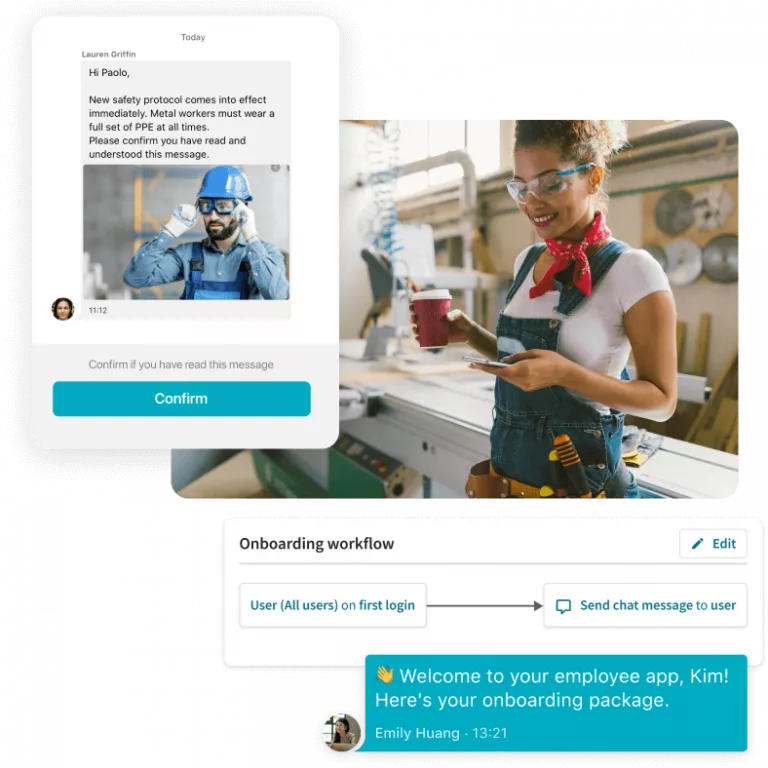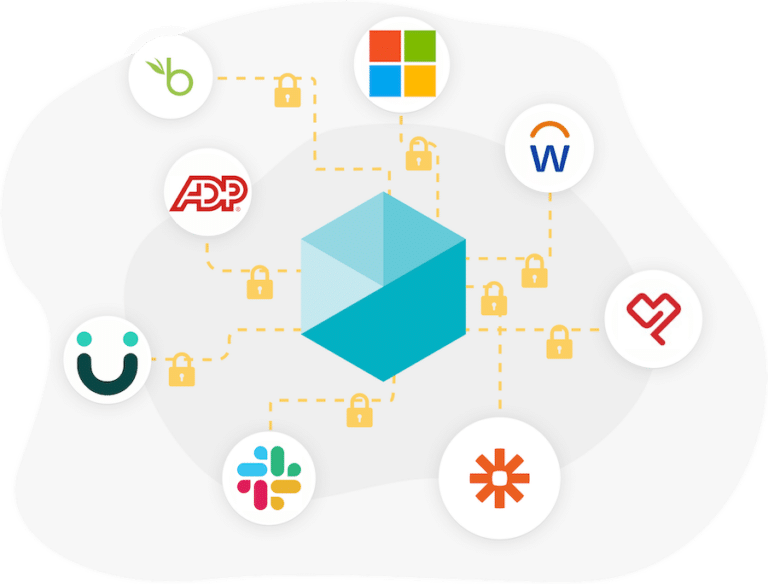10 Intranet Tools That Keep Everyone in the Loop

Intranet tools have been around for over 30 years, and for much of that time, they were the best way to facilitate internal communications in a company. But as technology has rapidly transformed the workplace, many of those traditional intranets people used on big clunky desktop computers have remained static harborers of outdated content.
In their place are more robust intranet management tools that complement how people work today. They are mobile, faster, and available to every type of worker, from the frontline staff to desk-based employees.
What are Intranet Software Tools?
The intranet is a private communication system often used by companies for employee communication. In the early days, the intranet was a basic and effective way for desk-based workers to communicate and collaborate. It was similar to today’s email servers but restricted to internal communication only. Some companies even took it a step further with internal websites to share company information.
The benefits were immediate. Faster communication, fewer meetings. Employees could easily share information and files.
So, why did those old intranets become outdated?
As workplace technology progressed, the intranets of yesteryear seemed to stay stagnant. They didn’t stay relevant with changing times, changing technology, or the changing nature of work. But some companies have held onto their legacy intranet systems, even as their effectiveness has dropped drastically over the past three decades.
In a survey by Prescient Digital Media, only 13% of respondents reported participating in their company’s intranet on a daily basis. In contrast, a staggering 31% said they never use their company intranet at all.
The top 10 pain points of those legacy intranet systems are:
- Current intranet platforms are clunky and not user-friendly leading to low adoption rates.
- Users have difficulty tracking and accessing information they need.
- There is an absence of real-time collaboration features.
- Traditional intranet tools don’t engage a dispersed or remote workforce.
- There are concerns about data security with existing intranet solutions.
- The fixed nature of intranets also make them less social, less engaging, and, most importantly, less collaborative.
- Many intranet tools are designed for computer users, which excludes dispersed and frontline workers.
- Content on decades-old intranets is outdated and irrelevant, making it difficult for workers to find what they need.
- Companies held onto old intranet systems even after they upgraded their hardware making them incompatible and slow.
- Old intranets must be upgraded with a la carte features that can be expensive.
The ability to connect and align everyone in an organization is a critical part of achieving business goals. When everyone is working from the same information, there is greater productivity. But 24% of workers feel the C-Suite isn’t using the company intranet. It creates an “us” and “them” feeling among workers and lowers morale.
The good news? There are so many alternatives and newer intranet tools that are more powerful, more adaptable, and more engaging. Just like other areas of your business that need re-investment to remain efficient and relevant, your internal communication platforms require the same. Mobile communication platforms are rapidly becoming the standard in internal communication, and are often a much more cost-effective method.
Meet Beekeeper. Your All-in-One Frontline Success System
The Benefits of Intranet Collaboration Tools
When a company has a modern intranet platform that is well managed, there are a number of ROIs that companies will start to notice.
The top five benefits include:
- Boost in operational productivity and efficiency with availability of real-time communication and instant access to information
- Fits today’s modern workscape by being available on mobile devices and computers
- Enables clear collaboration between colleagues
- Inclusive approach to running a company which increases engagement
- Creates a single source of truth by centralizing all information in one place
Common Mistakes Companies Make with Their Intranet
90% of company intranets fail within the first three years. Why? Companies often feel secure in knowing they have something in place. But intranet tools are not all designed equally.
Here are some common pitfalls of intranet tools:
- Companies build their own intranet which is expensive to assemble and maintain.
- Companies don’t update the content.
- Many legacy intranets are static systems, designed for desktops and companies fail to upgrade to new intranet tools.
- Having them as standalone systems without the ability to integrate with other enterprise technology.
- 80% of today’s workforce is not at a desk or a computer. They are on the frontlines and mobile. Traditional intranet tools were built for desk-based workers.
The best thing a company can do for their employees is to swap out their old intranet for a modern workplace system that is dynamic and engaging. And there is no shortage of great options.
10 Top Intranet Tools for Collaboration and Management
Many of us keep our vehicles for a decade or two. As long as they run and get us to where we need to go, why invest in a new one? Then, lights start to come on and minor things start to happen. It still drives but it’s not like it once was. But test drive a newer vehicle and you’ll see the upgrades and features that have emerged since we last went car shopping that have made driving safer, smoother, and a better overall experience. It’s the same with today’s intranet. The old one might work, but it’s not giving you the performance you need.
After your employees start using dynamic, interactive, real-time mobile correspondence tools, a static web-based intranet hub will begin to look a little stale to say the least. Those intranets are often full of irrelevant content due to the passage of time, they are clunky, and lack a simple user interface, and are often far more expensive to maintain than they are worth to your organization’s overall productivity levels.
If you’re ready for an upgrade, here are 10 great options for intranet software tools that can revolutionize internal communication in your company.
1. Happeo: Best for Remote Teams to Access Information
38% greater productivity. 65% faster content finding. And happy “Happeo” customers. Not bad stats for a modern intranet tool. Happeo caters to companies of all sizes and in any industry, as long as they use Google Workspace or Microsoft 360. Happeo makes collaboration easy by centralizing information into one digital workspace for a single source of truth. And it’s a super easy rollout that takes just six to eight weeks (compared to over a year.)
Top Features
- Pages keep teams connected and aligned.
- Interactions enable direct communication and engagement.
- Universal search creates a fast, easy way to find information or conversations.
Pricing
Happeo’s pricing has three tiers. Companies can begin with the Starter package which offers a free trial. Then there is the Growth level and finally, the Enterprise level which comes with 24/7 support. Companies can select the level that works best for their needs.
2. Softr: Best Customizable Intranet Tool
Softr is a unique tool. It allows customers to use it for a multitude of purposes: operations, marketing, sales, HR, and customer support. Companies can even create external portals to share information with clients. Bonus: Softr works on most operating systems.
Top Features
- Customizable templates make it easy to build dynamic sites.
- Integrations with many popular tools like Stripe and Zapier.
- Community hubs for users to share resources and find contacts.
Pricing
Softr has multiple pricing options. The first level is free for individuals starting up. Next is the basic level for $49 a month. Professional and business levels are $139 and $269 a month. For large organizations, pricing is customized to their needs. But the four previous levels are reasonable and are far more cost-effective than building your intranet.
3. Notion: Best for AI-Powered Intranet
Notion is part intranet and part project management tool, making it easy for companies to streamline information and share with users, create roadmaps and timelines. The tool makes it easy to sort, organize, and find files that teams can edit and work on simultaneously. And the best part? Notion has a powerful AI generator that can help companies amplify messaging and automate tasks and workflows.
Top Features
- Notion AI is a virtual assistant that helps users by answering questions, auto-filling forms,
- Email campaigns help customers send out mass “mailings” like newsletters.
- Customizable docs that make it easy to create and share documents (even integrating images and videos) with colleagues.
Pricing
For a very basic collaborative workspace, Notion offers a free version. Notion Plus offers a space for up to 100 users and costs $8 a month if paid annually, and $10 a month if paid monthly. At the Business level there can be up to 250 users which is great to connect multiple teams for the price of $15 a month ($18 if paid month to month.) The Enterprise level has customized pricing but is a great solution to connect everyone in an organization and does not have a limit on page history, has powerful analytics, and higher security. The Notion AI feature is an extra $8 a month, billed annually (or $10 a month paid monthly.)
4. Click Up: Best for Collaboration
ClickUp streamlines workflows for faster collaboration. The intranet collaboration tool is easy for each user to customize to their own preferences. From CRM to marketing to operations, ClickUp has great visibility across teams, and even has a dedicated version for nonprofits. And in case you need a stamp of approval, ClickUp boasts customers like Netflix, Spotify, and IBM.
Top Features
- Tasks allows users to organize and visualize to do lists to make work more efficient.
- Native Time Tracking is a unique feature that allows users to track time on each project which makes billing easier.
- Mind Maps take brainstorming to the next level with the ability to build tasks and workflows
Pricing
ClickUp has four pricing levels. For individuals, the Free Forever is, well, free. The Unlimited plan is best for small teams and costs $7 a month per member. The Business level is $12 a month per member. For Enterprise pricing, interested customers need to call the sales team, but it’s the option for entire companies who want the project management power that ClickUp offers.
5. Simpplr: Best for Employee Experience
Simpplr is an intranet tool committed to making work easier to improve the employee experience. Whether an employee is at a desk or on the frontline, every user can customize Simpplr to work best for them which adds a personal touch for remote colleagues to connect. Simpplr is a popular intranet tool for industries with frontline workers for that reason. And it is powered by AI to make work smoother and more efficient.
Top Features
- Onboarding is easy with Simpplr with training videos, paperwork, and compliance information all on the tool for faster time to productivity.
- Federated Search is an AI-powered search tool that helps employees quickly find exactly what they need from multiple data sources and with multi-lingual support.
- Auto-Governance Engine is an automated “clean up” system that archives older content to ensure the most recent and relevant information is quickly accessible.
Pricing
Just like Simpplr can be personalized for each user, its pricing is tailored to each customer based on need.
6. Confluence: Best for Cross-Functional Teams and Tools
Confluence is in the Atlassian family, a brand known for powerful workspace tools. This organizational intranet tool can easily integrate with Atlassian’s other products, like Jira, a bonus for customers. Designed to support remote and dispersed workforces, Confluence makes collaboration easy through one centralized system.
Top Features
- Whiteboards are exactly that—digital whiteboards where colleagues can post sticky notes (and turn them into Jira tasks) and embed content to collaborate and innovate.
- Templates give teams a starting point to create their digital workspace and users can even use a Confluence template or choose one from a number of partners, like Zendesk or HubSpot.
- Content trees allow users to organize projects and information to make it easy for teams to access what they need for more efficient workflows.
Pricing
Like the other intranet tools, there are four pricing levels for Confluence. The free level is good for individuals and small groups up to ten, and the Basic level jumps to 50,000 users for $60.50 a month. The Premium step is $115 a month with unlimited storage. Finally, the Enterprise level needs to be priced directly with the sales team, but allows up to 150 sites to accommodate any and every team.
7. Interact: Best for Internal Communication
Interact is a digital workplace designed to enhance the employee experience. AI-supported content management helps engage and include workers. Pulse surveys make it easy to get employee feedback. Interact has many bells and whistles that make it an intranet management tool worth using.
Top Features
- Digital signage extends the reach of this intranet tool so every employee can see important messages, especially those who don’t sit at a desk.
- Homepages are a customizable starting point to launch employees into the intranet with all of the information they need.
- Communities are a way to bolster the employee experience with specific pages for teams and non-work related groups, like employee clubs, to increase engagement.
Pricing
The pricing for Confluence is determined by exactly what a company needs: the number of users, technical support, and volume.
8. Staffbase: Best for Employee Engagement
Staffbase is a mobile-first app that empowers employees by meeting them where they’re at. It is designed with frontline workers in mind. It’s an inclusive platform with a powerful content management system. All communication happens on Staffbase which eliminates silos and connects everyone.
Top Features
- Smart Impact is Staffbase’s analytics software that helps turn real-time data into actionable insights that help companies reach better outcomes.
- Automated onboarding helps engage employees from their first day on the job with digital forms that make onboarding quick and easy.
- Employee newsletter designer helps companies craft the most effective newsletters to engage workers.
Pricing
Staffbase has three pricing levels: Starter, Business, and Enterprise. Prices vary depending on a customer’s needs so quotes need to be sourced directly from Staffbase.
9. Unily: Best for Employee Engagement
Designed for desk-based and frontline workers alike, Unily is an AI-powered intranet and digital workplace crafted for productivity and collaboration. It does all the things a company needs in an intranet, and then some. It goes above and beyond in employee engagement (like with the tool’s Gamification feature).
Top Features
- Employee journeys help design a structured and personalized journey so each employee stays engaged and hits targeted career milestones and receives proper training to achieve career goals.
- Campaign automation allows internal communications leads to send out targeted and automated messaging and build an internal marketing system to increase engagement.
- Gamification is a part of Unily’s unique features designed to lighten up the day and engage employees.
Pricing
Pricing for Unily depends on what you want your intranet to do. Pick the features you need and the number of users and you’ll get a custom quote.
10. Jostle: Best for Scaling as You Grow
Jostle is an intranet tool designed to engage employees and make it easy for them to contribute on the platform. It’s easy to track who has read important messages to ensure wide-scale reach. It’s got a unique focus on employee success and is designed to help support every worker in an organization.
Top Features
- JostleTV is a really unique feature that allows companies to send out visual messaging via screens placed throughout a workplace to keep people connected whether they’re away from their computer or don’t work at one.
- Library centralizes company information for easy access by everyone but is still maintained by the content owner.
- Listings is an internal marketplace, allowing employees to swap shifts or even list an item for sale.
Pricing
Jostle’s pricing has four levels: Bronze, Silver, Gold, and Platinum. Each level offers progressively more features. The cost of each is based on number of users. The price per user increases with a higher number of employees.
Transform your Intranet into a Modern, Mobile Solution
The fixed nature of intranets make them less social, less engaging, and, most importantly, less collaborative. For dispersed workforces who rely on digital checkpoints to provide feedback and execute projects, lacking the ability to connect directly with coworkers on the intranet is problematic. While traditional intranets do a decent job of connecting people to information, they fail miserably at connecting people to other people.
As the workplace continues to evolve and digital transformation continues, there is one question that operations, HR, and IT professionals face across industries: “When we optimize our workplace communication with a mobile-first solution, what will become of our on-network company intranet?” Companies can salvage parts from their old intranet and turn it into a modern tool. Look at your intranet like an aging car. When you lift up the hood, determine the pieces of content that your employees still engage with regularly.
You can determine this in two different ways:
- Look at your backend analytics to see which portals and knowledge base articles your employees engage with the most. Update them to make them relevant and transfer them to your new system.
- If you don’t have access to your intranet engagement analytics or would simply prefer more anecdotal feedback from your employees, send out a pulse survey to gauge which aspects of the current CMS hub they still use and/or find helpful in their everyday workflow.
Then, start to build your modern, mobile-first solution with Beekeeper.
Use Beekeeper to Make Your Intranet More Powerful
With Beekeeper, the power of each of these intranet tools can be amplified. Through one central, powerful platform, a company can maximize productivity by distributing information to every single employee. Studies show that workers want to feel connected to the people they work with and a part of a “cohesive team,” according to McKinsey. And this is what Beekeeper and an intranet tool can do.
Here are three easy steps that will help you successfully converge your aging CMS with your new mobile-first workplace platform.
1. Automate
Automated workflows, communication streams, and content updates allow for a more dynamic intranet system to emerge. A common pain point among traditional intranet users is that legacy hubs are resource-intensive to maintain, with technical ownership of the site frequently remaining murky or unassigned. With no one to steer the ship, documents, and modules become quickly outdated and useless.

Beekeeper, on the other hand, was specifically designed to self-regulate as much as possible, including workflows, newsletters, and survey dispatches. While it may seem counter-intuitive that workforce automation makes Beekeeper more dynamic and human, it’s touches like these that help your employees integrate the digital work hub into their everyday routines, making life less about logistics and more about productivity. Automating repetitive tasks frees workers up to do more value-add projects that enhance their feeling of purpose-driven work. This ultimately builds engagement and boosts retention.
2. Integrate
Beekeeper marketplace is a great place to start brainstorming ways in which your legacy intranet can be updated for mobile and real-time use. For instance, if analytics or anecdotal feedback suggests that employees find the intranet’s company personnel directory useful to keep tabs on team members, you might consider a Bamboo HR integration.

This would allow employees to upload photos, fun facts, and critical contact information for colleagues to quickly access to get in touch or get to know their teammates better. Another prime example of this would be implementing a Box integration, which would allow you to upload and maintain all frequently trafficked knowledge base articles and training materials to a centralized digital hub within Beekeeper. This allows employees to quickly look up and access files without having to dig through a graveyard of poorly managed documents that may or may not be up to date with the latest content.
3. Personalize
Company intranets should feel like a warm and lively gathering, not a ghost town. Carrying strong brand assets throughout your internal communications hub is a great way to encourage employee engagement and collaboration. Whereas a traditional intranet can feel as sterile and stark as a windowless chamber, the Beekeeper digital workplace is an interactive space that thrives when every user contributes.
That’s why the Beekeeper interface allows individual employees to customize their settings, and actions like push notifications and workflows, giving a more personalized feel to the workplace experience. In addition to increasing productivity, these interactive features and notifications also encourage higher levels of participation within the company culture, leading to higher levels of overall workforce satisfaction.
Ready to Choose the Right Intranet Tools for Your Workplace?
The goal of Beekeeper is to seamlessly augment and integrate with the tools that your employees already use and love, while replacing the tools that may be stuck in the past. Mobile apps are the primary method of communication for today’s workforce, and Beekeeper was built as a mobile-first solution for this reason.
Beekeeper enables employees to engage with their employer in the same way that they engage with their friends and family— on the go and their own terms. While simply serving up content on static intranet tools falls radically short of this goal, building a dynamic, digital space for employees to connect encourages all team members to find their purpose, be active contributors at work, and feel a sense of belonging. What follows are the positive business outcomes that every leader is looking to achieve.

About the author
Andreas Slotosch
Chief Growth Officer
Andreas is one of the Co-Founders and VP of Growth at Beekeeper. Prior to Beekeeper, he was involved in various web start-ups and worked for several international companies in the area of business development and marketing. Andreas is a graduate of the University of St. Gallen and author of numerous blogs and book contributions on the topic of mobile internal communication and employee engagement.






